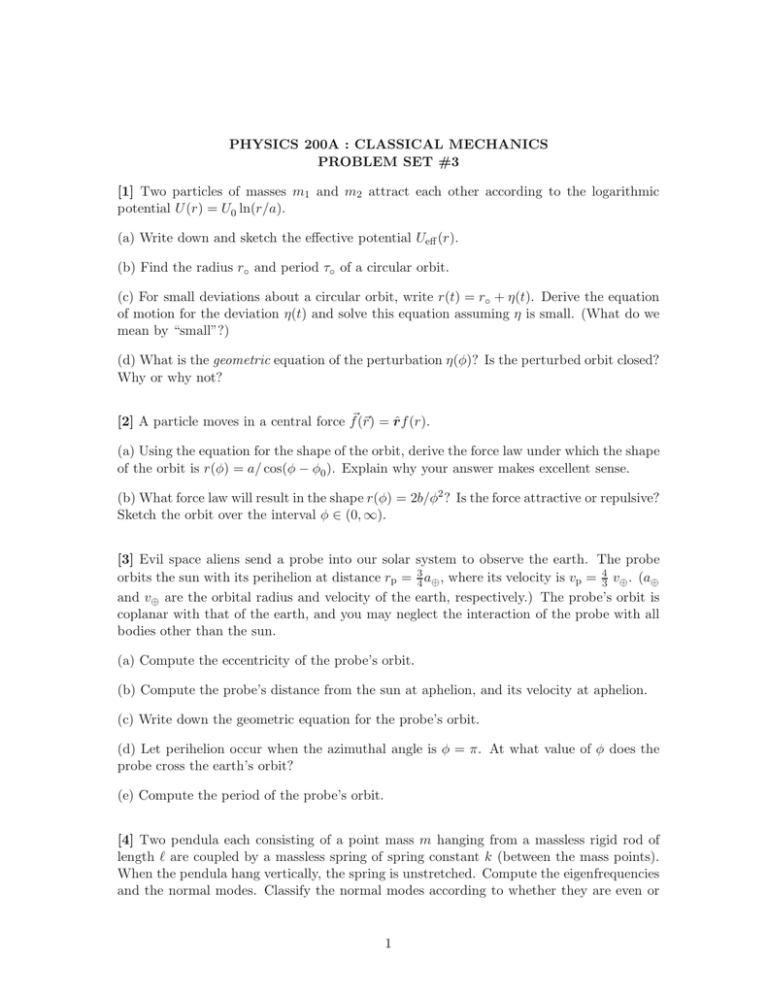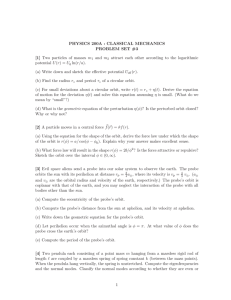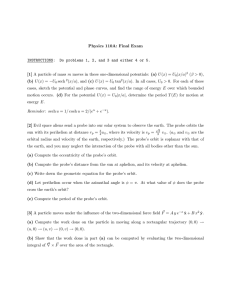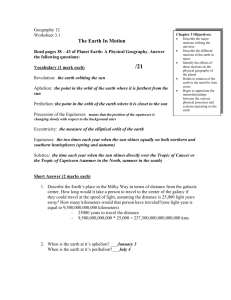PHYSICS 200A : CLASSICAL MECHANICS PROBLEM SET #3 and m
advertisement

PHYSICS 200A : CLASSICAL MECHANICS PROBLEM SET #3 [1] Two particles of masses m1 and m2 attract each other according to the logarithmic potential U (r) = U0 ln(r/a). (a) Write down and sketch the effective potential Ueff (r). (b) Find the radius r◦ and period τ◦ of a circular orbit. (c) For small deviations about a circular orbit, write r(t) = r◦ + η(t). Derive the equation of motion for the deviation η(t) and solve this equation assuming η is small. (What do we mean by “small”?) (d) What is the geometric equation of the perturbation η(φ)? Is the perturbed orbit closed? Why or why not? [2] A particle moves in a central force f~(~r) = r̂f (r). (a) Using the equation for the shape of the orbit, derive the force law under which the shape of the orbit is r(φ) = a/ cos(φ − φ0 ). Explain why your answer makes excellent sense. (b) What force law will result in the shape r(φ) = 2b/φ2 ? Is the force attractive or repulsive? Sketch the orbit over the interval φ ∈ (0, ∞). [3] Evil space aliens send a probe into our solar system to observe the earth. The probe orbits the sun with its perihelion at distance rp = 34 a⊕ , where its velocity is vp = 43 v⊕ . (a⊕ and v⊕ are the orbital radius and velocity of the earth, respectively.) The probe’s orbit is coplanar with that of the earth, and you may neglect the interaction of the probe with all bodies other than the sun. (a) Compute the eccentricity of the probe’s orbit. (b) Compute the probe’s distance from the sun at aphelion, and its velocity at aphelion. (c) Write down the geometric equation for the probe’s orbit. (d) Let perihelion occur when the azimuthal angle is φ = π. At what value of φ does the probe cross the earth’s orbit? (e) Compute the period of the probe’s orbit. [4] Two pendula each consisting of a point mass m hanging from a massless rigid rod of length ℓ are coupled by a massless spring of spring constant k (between the mass points). When the pendula hang vertically, the spring is unstretched. Compute the eigenfrequencies and the normal modes. Classify the normal modes according to whether they are even or 1 odd with respect to the group Z2 , generated by the elements I (identity) and P (reflection about a vertical line midway between the two pendula). [5] In equilibrium, a collection of six identical springs k and four identical masses m are arranged in a perfect tetrahedron. (a) One way to identify the vertices of a tetrahedron is to inscribe it in a cube of side length 2a. With the origin at the center, the coordinates of the vertices may be taken as (−a, a, a), √ (a, −a, a), (a, a, −a), and (−a, −a, −a). The side length of the tetrahedron is then b = 2 2a. (i) (b) Find all the zero modes and provide explicit expressions for their eigenvectors ψσ . How many zero modes should there be? (c) Find numerically all the remaining normal modes and their eigenfrequencies. (d) The tetrahedral group Td , i.e. the discrete group of symmetry operations acting on a tetrahedron, has 24 elements (arranged among five conjugacy classes) and five irreducible representations (‘irreps’). The A1 and A2 irreps are each one-dimensional, the E irrep is two-dimensional, and the T1 and T2 irreps are each three-dimensional. (If you sum the squares of the dimensions of the irreps, you always get the order of the group, i.e. the number of group elements. Lo and behold: 12 + 12 + 22 + 32 + 32 = 24.) Based on the degeneracy of your finite frequency normal modes, identify what possible irreps they might belong to. 2





